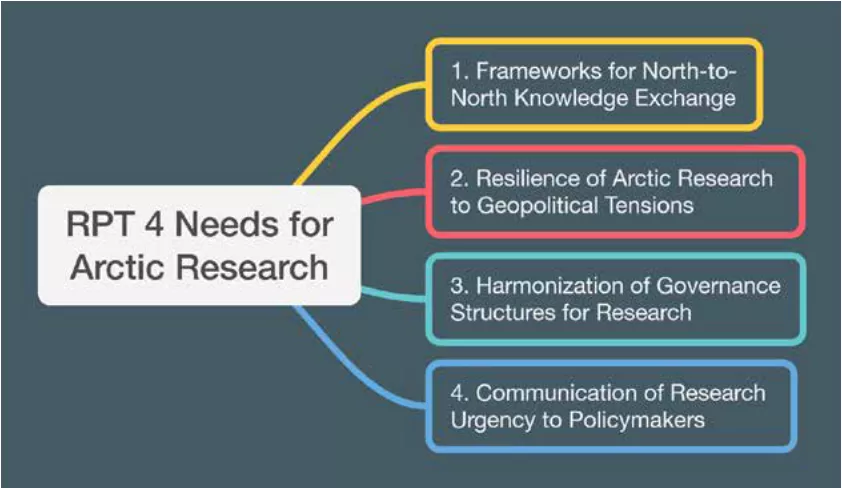Pan-Arctic Science Research Collaboration
A chapter of the Arena for the Gap Analysis of Existing Arctic Science Co-Operations (AASCO) White Paper
A chapter of the Arena for the Gap Analysis of Existing Arctic Science Co-Operations (AASCO) White Paper
This chapter is excerpted from the The Arena for the Gap Analysis of Existing Arctic Science Co-Operations (AASCO) White Paper, which summarizes the key insights and recommendations from AASCO 2025 Monaco summit. The recommendations focus on eight critical topics: Arctic sea ice and Greenland Ice Sheet dynamics, the role of Short-Lived Climate Forcers (SLCFs), the interplay between Arctic processes and the coupled climate system, Arctic climate interventions, Arctic air pollution, the role of co-production and local communities, pan-Arctic collaboration and data-sharing and Artificial Intelligence (AI).
Guiding Questions:
Pan-Arctic research cooperation is essential because natural and human systems in the Arctic are diverse yet interconnected, necessitating a collaborative approach. The opportunities and challenges facing the Arctic are complex, and a full understanding can only be achieved through the recognition and inclusion of diverse knowledge systems, disciplines and perspectives. Cooperation is crucial for generating useful knowledge at multiple scales, ranging from local to global, and supporting the entire research-to-action process. For over 30 years, the Arctic region has demonstrated the value of Arctic research cooperation, and dedicated particular attention to prioritizing the needs and voices of the region’s Indigenous Peoples. Sustaining these efforts despite growing geopolitical tension in the region is critical for addressing both present and future needs both regionally and globally. Moreover, Arctic research cooperation provides important opportunities to foster mutual understanding and strengthen relationships between rights holders and stakeholders with diverse needs and perspectives. Ultimately, research should inform the development of effective policies and actions, while those policies and actions, in turn, help facilitate the generation of high-quality research.
The vision for pan-Arctic research collaboration in 2035 is to remain resilient and productive despite geopolitical tensions, focusing on collective action and shared goals for the Arctic. It should be inclusive, incorporating a wide range of knowledges, experts, and perspectives, ensuring that diverse interests are represented and valued and the needs of Arctic communities are prioritized. There should be a significant investment in mechanisms and infrastructure to effectively collect, share, and disseminate data, knowledge, and lessons learned across the global research community. This infrastructure needs to build a sense of common interest and action, leveraging existing tools such as the CAOFA, Arctic Science Cooperation Agreement, Arctic Council, and IASC to coordinate efforts and strengthen collaboration.
By 2035, Arctic research should aim to better integrated, with a more unified approach to addressing challenges and opportunities across disciplines and sectors. The research community can be one that continuously evolves, learning from both its successes and its mistakes to drive better outcomes for the future.
A challenge for pan-Arctic research collaboration is matching funding to research needs, including issues related to institutional support, startup costs, long-term investments, and operational expenses. Incentivizing collaboration between researchers and other knowledgeholders that there are sufficient motivations and rewards for working together and co-create knowledge across disciplines and borders that are critical for effective collaboration. Finally, decentralized research is an issue, as it is often research fragmented by boundaries and divisions, which can hinder the coordination and integration needed for effective collaboration.
Pan-Arctic research cooperation is vital due to the interconnected and complex challenges facing the Arctic, which require a collaborative approach that incorporates diverse knowledge systems and perspectives. Emphasizing the needs of Indigenous Peoples and fostering mutual understanding among stakeholders, this cooperation aims to generate valuable insights that support both local and global needs. By 2035, the vision is for productive research communities that prioritizes inclusivity, invests in infrastructure for data sharing, and adapts continuously to improve outcomes. Addressing funding, institutional support, and fragmentation challenges will be crucial for enhancing effective collaboration across disciplines and borders in the Arctic region.

“Pan-Arctic Science Research Collaboration.” Edited by Spence, Jennifer and Kamrul Hossain. University of Helsinki, March 25, 2025